Birdfinding.info ⇒ Locally common in several parts of its range, including Bali and the western lowlands of the Malay Peninsula from the Thai border area to Singapore. Consistent sites on Bali include Bali Barat National Park and Denpasar; in Malaysia, Penang and Taman Botani Negara Shah Alam in Kuala Lumpur; and in Singapore, Lorong Halus and Kranji Marsh. On Java, it can often be found in and around Jakarta: e.g., Pulau Dua Nature Reserve and Bogor Botanical Garden. Scarce in Thailand, mainly in the extreme south around Songkhla. On Martinique, it is sometimes found on the Caravelle Peninsula and along the eastern side of the Fort-de-France Airport.
White-headed Munia
Lonchura maja
Southern Vietnam, the Malay Peninsula, and western Indonesia, where it inhabits marshes, lush grassy areas, and similar types of agricultural land such as rice paddies and cane fields.
Mainly on the Malay Peninsula (north to Surat Thani, Thailand), Sumatra, Java, Bali, and nearby islands such as Langkawi, Pulau, Nias, and Siberut.
Although authoritative sources consider Bali to be its eastern limit, there are many scattered reports eastward across the Lesser Sundas, including Lombok, Sumbawa, Flores, and western Timor. Some of these may be misidentified Pale-headed Munias (see below for comparison), but the records are numerous enough that it seems likely that White-headed regularly occurs east of Bali—especially on Lombok, where the reports are concentrated on the western side, directly across the channel from Bali.
A separate population in Vietnam is mainly associated with the Mekong Delta, but has been reported north to Da Nang (central Vietnam).
Introduced and apparently established in the Lesser Antilles on Martinique. Small populations were at least briefly established in Japan around Tokyo and on one or more of the Ryukyu Islands.
Identification
A small, brown finch with a very large, pale blue or whitish bill, and a full white hood that gradually blends to brown on the neck.
The hood is not always bright-white, and on many individuals it is either all or partly buffy, especially on the throat. In some cases the tone is grayish rather than white or buffy.
The rest of its plumage is typically three distinct colors: the upperparts, chest, and sides are mostly warm-brown, often rusty; the lower breast and belly are blackish; and the flanks, rump, and uppertail are a deep reddish, chestnut shade of brown. (However, some have distinctly brown—not blackish—bellies.)

White-headed Munia, typical plumage. (Bali, Indonesia; July 11, 2008.) © Eling Lee
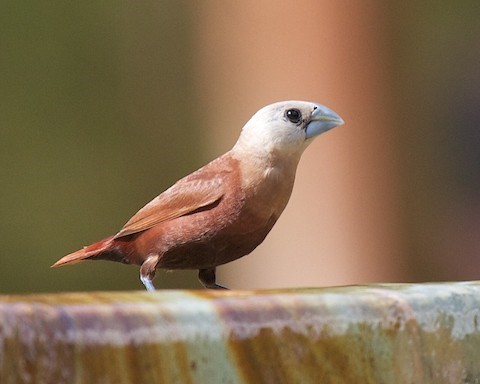
White-headed Munia, an atypically pale plumage with brown—not blackish—belly. (Bali Barat National Park, Bali, Indonesia; July 13, 2010.) © Robert Tizard
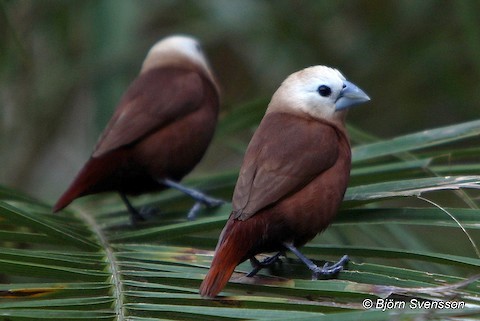
White-headed Munias, showing gradual, blended color transition from white head to brown back. (Yogyakarta, Java, Indonesia; February 23, 2013.) © Björn Svensson
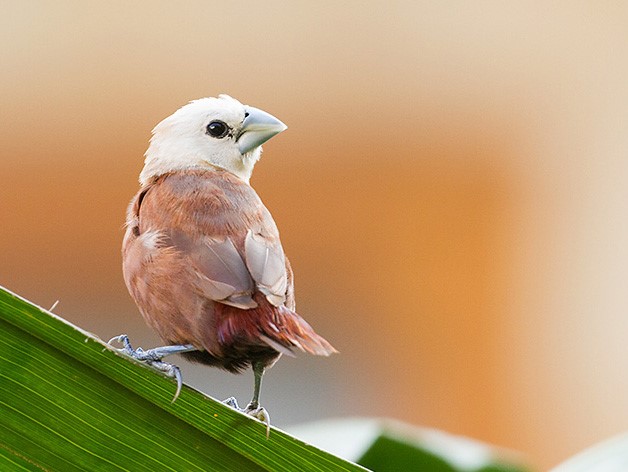
White-headed Munia, dorsal view, appearing pale in strong light. (Depensar, Bali, Indonesia; July 27, 2015.) © Peter Ericsson

White-headed Munia, ventral view showing progression from white hood to blackish belly. (Tambun, Perak, Malaysia; August 31, 2014.) © Amar-Singh HSS

White-headed Munia with brown throat. (Bali Barat National Park, Bali, Indonesia; January 12, 2006.) © Mehd Halaouate

White-headed Munia, dorsal view showing contrast between medium-brown back, wings and sides, and deep reddish chestnut rump and tail. (Sungai Balang, Johor, Malaysia; April 13, 2016.) © Shafeeq Wilson
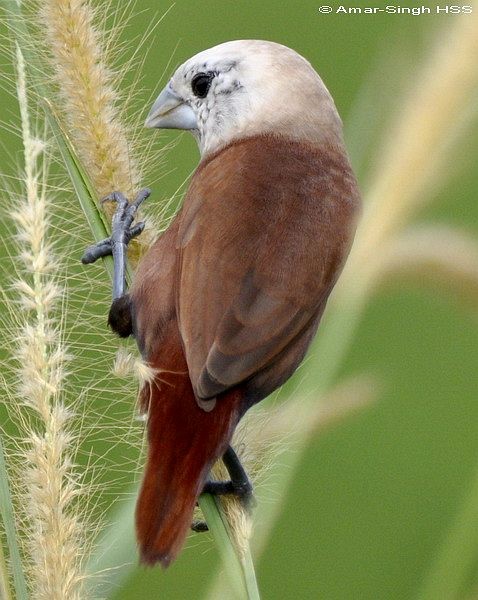
White-headed Munia, dorsal view showing contrast between medium-brown back, wings and sides, and deep reddish chestnut rump and tail. (Ipoh, Perak, Malaysia; February 27, 2010.) © Amar-Singh HSS
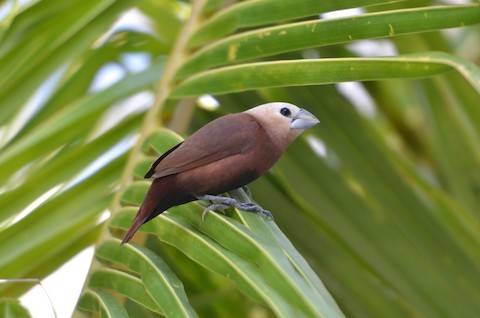
White-headed Munia, ventral view showing transitions from light to dark on underparts. (Bandar Udara International Ngurah Rai, Bali, Indonesia; January 27, 2019.) © Dirk Tomsa
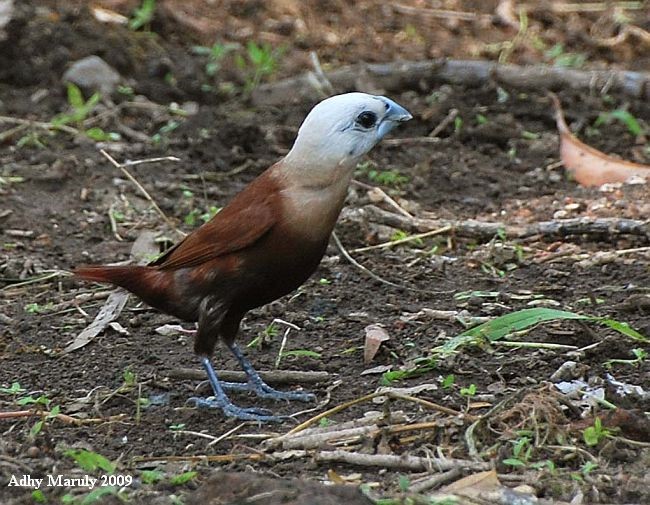
White-headed Munia, molting its tail feathers. (Yogyakarta, Java, Indonesia; May 8, 2009.) © Adhy Maruly
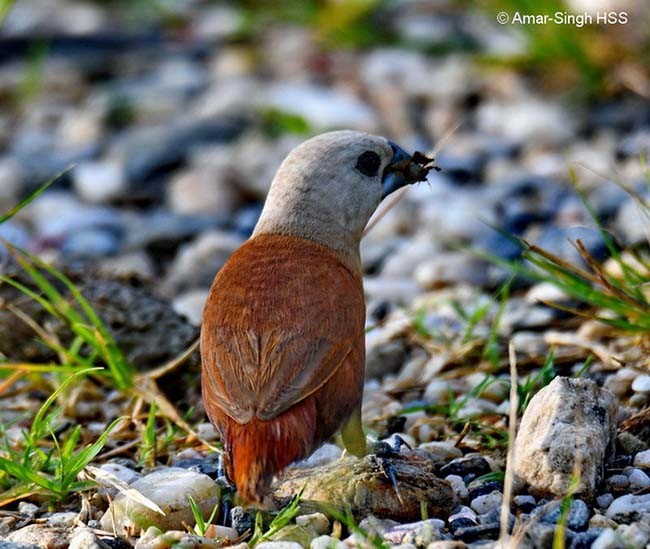
White-headed Munia with bright rusty upperparts, dingy-white head, and dark-shaded bill. (Ipoh, Perak, Malaysia; May 26, 2017.) © Amar-Singh HSS
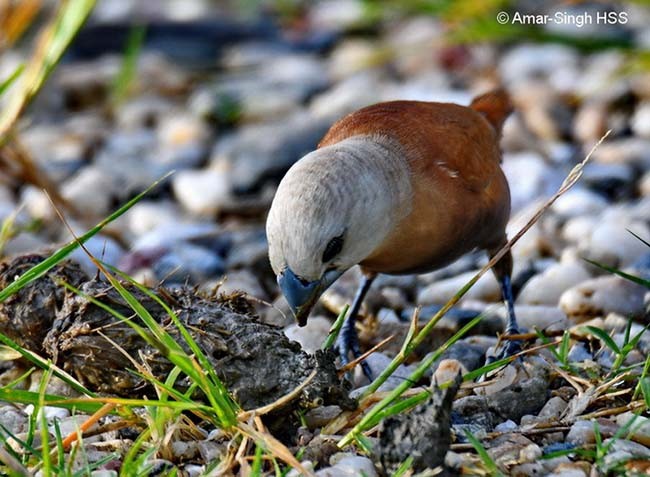
White-headed Munia with dingy-white head and dark-shaded bill. (Ipoh, Perak, Malaysia; May 26, 2017.) © Amar-Singh HSS
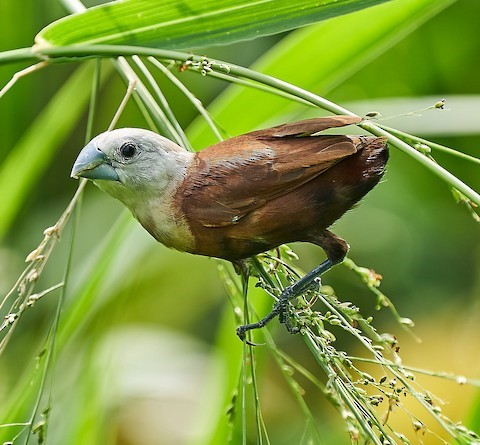
White-headed Munia, molting its tail feathers. (Pasir Ris Park, Singapore; February 6, 2020.) © Steven Cheong
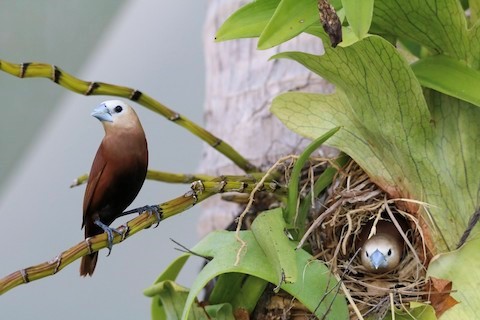
White-headed Munia, pair at nest. (Bali, Indonesia; December 18, 2018.) © Docs in the Wild
Immatures begin mostly tan above and below, then become roughly bicolored as the upperparts darken and the underparts blanch, then the definitive adult coloration appears in patches.
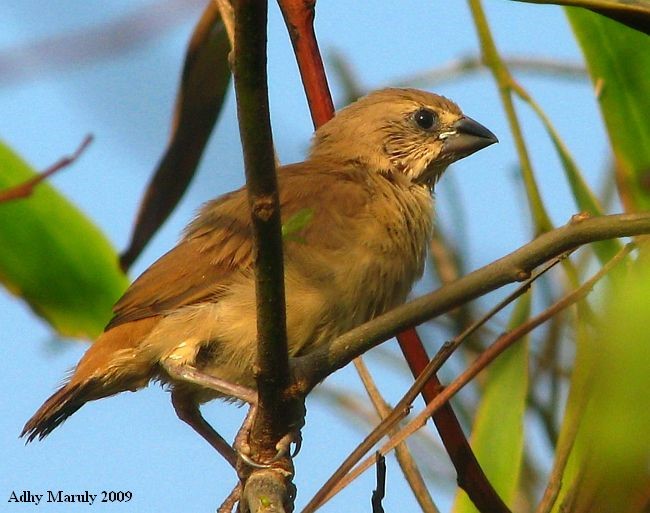
White-headed Munia, immature. (Trisik Beach, Yogyakarta, Java, Indonesia; July 25, 2009.) © Adhy Maruly

White-headed Munia, immature. (Lorong Halus, Singapore; July 3, 2016.) © Mohit Kumar Ghatak
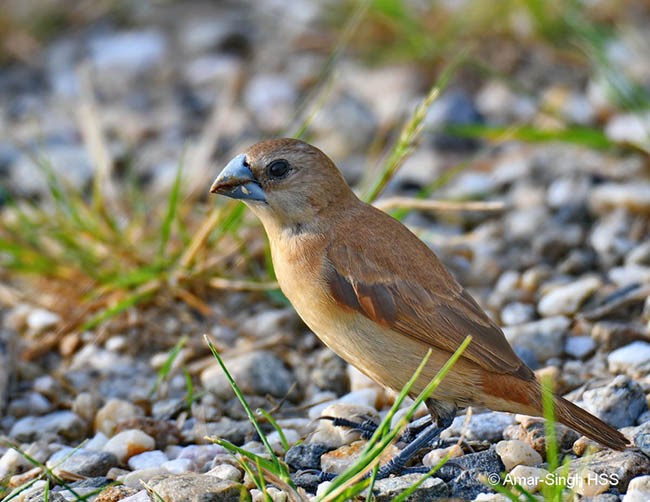
White-headed Munia, immature. (Ipoh, Perak, Malaysia; May 26, 2017.) © Amar-Singh HSS
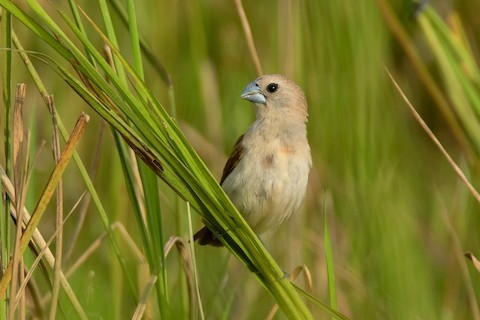
White-headed Munia, immature with dark upperparts and pale underparts. (Ko Taeo, Songkhla, Thailand; July 16, 2017.) © Ayuwat Jearwattanakanok

White-headed Munia, immature molting into adult plumage. (Ipoh, Perak, Malaysia; February 27, 2010.) © Amar-Singh HSS
Voice. Common calls include a soft, two-syllable whistle, “pi-dew!”:Also whistled notes that alternate between high and low, and escalate to a rapid, “pinballing” cadence:The song is reportedly “a high-pitched and constantly repeated tinkling “heeheehee.” (Clement et al. 1993)
Cf. Pale-headed Munia. White-headed and Pale-headed Munias do not usually overlap, but apparently occur together occasionally through introductions or natural inter-island wandering in the Lesser Sundas. In such cases, they are readily confused—especially due to variation within Pale-headed.
Some Pale-headed look like a washed-out or bleached version of White-headed, with the same white hood but dramatically paler underparts. However, many Pale-headed have fairly dark-brown underparts and therefore give essentially the same impression as White-headed.
Pale-headed Munias at the dark end of the spectrum differ from White-headed in two ways: (1) the underparts are rich, rusty brown, whereas White-headed is blackish; and (2) the contrast between the white hood and the brown body is crisp, whereas White-headed shows a gradual, blended color transition.
Cf. White-capped Munia. White-headed and White-capped Munias overlap on the Malay Peninsula, Sumatra, Java, and Bali, and are strikingly similar except for the throat and chest, which are pale on White-headed but blackish on White-capped.
They also differ, but more subtly in the demarcation between the white nape and brown back. On White-headed the color transition is gradual and blended, whereas on White-capped the line of contrast is crisp.
Notes
Monotypic species.
References
BirdLife International. 2016. Lonchura maja. The IUCN Red List of Threatened Species 2016: e.T22719851A94647970. https://dx.doi.org/10.2305/IUCN.UK.2016-3.RLTS.T22719851A94647970.en. (Accessed April 7, 2020.)
Brazil, M. 2009. Birds of East Asia. Princeton University Press, Princeton, N.J.
Clement, P., A. Harris, and J. Davis. 1993. Finches and Sparrows: An Identification Guide. Princeton University Press, Princeton, N.J.
eBird. 2020. eBird: An online database of bird distribution and abundance. Cornell Lab of Ornithology, Ithaca, N.Y. http://www.ebird.org. (Accessed April 7, 2020.)
Kirwan, G.M., A. Levesque, M. Oberle, and C.J. Sharpe. 2019. Birds of the West Indies. Lynx Edicions, Barcelona.
Payne, R. 2020. White-headed Munia (Lonchura maja). In: del Hoyo, J., Elliott, A., Sargatal, J., Christie, D.A. & de Juana, E. (eds.). Handbook of the Birds of the World Alive. Lynx Edicions, Barcelona. https://www.hbw.com/node/61197. (Accessed April 7, 2020.)
Restall, R. 1997. Munias and Mannakins. Yale University Press, New Haven.
Xeno-Canto. 2020. White-headed Munia – Lonchura maja. https://www.xeno-canto.org/species/Lonchura-maja. (Accessed April 7, 2020.)

